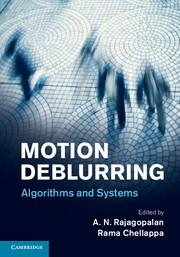Book contents
- Frontmatter
- Contents
- List of contributors
- Preface
- 1 Mathematical models and practical solvers for uniform motion deblurring
- 2 Spatially-varying image deblurring
- 3 Hybrid-imaging for motion deblurring
- 4 Efficient, blind, spatially-variant deblurring for shaken images
- 5 Removing camera shake in smartphones without hardware stabilization
- 6 Multi-sensor fusion for motion deblurring
- 7 Motion deblurring using fluttered shutter
- 8 Richardson–Lucy deblurring for scenes under a projective motion path
- 9 HDR imaging in the presence of motion blur
- 10 Compressive video sensing to tackle motion blur
- 11 Coded exposure motion deblurring for recognition
- 12 Direct recognition of motion-blurred faces
- 13 Performance limits for motion deblurring cameras
- Index
- References
2 - Spatially-varying image deblurring
Published online by Cambridge University Press: 05 June 2014
- Frontmatter
- Contents
- List of contributors
- Preface
- 1 Mathematical models and practical solvers for uniform motion deblurring
- 2 Spatially-varying image deblurring
- 3 Hybrid-imaging for motion deblurring
- 4 Efficient, blind, spatially-variant deblurring for shaken images
- 5 Removing camera shake in smartphones without hardware stabilization
- 6 Multi-sensor fusion for motion deblurring
- 7 Motion deblurring using fluttered shutter
- 8 Richardson–Lucy deblurring for scenes under a projective motion path
- 9 HDR imaging in the presence of motion blur
- 10 Compressive video sensing to tackle motion blur
- 11 Coded exposure motion deblurring for recognition
- 12 Direct recognition of motion-blurred faces
- 13 Performance limits for motion deblurring cameras
- Index
- References
Summary
Camera shake is one of the most common causes of image blur. This type of blur arises when a long exposure is required (due to low light levels, for example), and the camera is not held still.
Removing blur due to camera shake is a very active area of research. With just a single photograph as input, this blur removal is known as the blind deconvolution problem, i.e. simultaneously recovering both the blurring function (point spread function or PSF) and the deblurred, latent image. Unfortunately, the blind deconvolution problem is inherently ill-posed, as the observed blurred image provides only a partial constraint on the solution. Therefore, the problem cannot be solved without assuming constraints or priors on the blur or the deblurred image. The most common assumption is that the blur is spatially invariant, but this can handle only a limited set of camera motions. The deblurred image is typically assumed to have natural image statistics (Fergus, Singh, Hertzmann, Roweis & Freeman 2006). A key open problem is to model general camera motions, which are quite common and can cause the blur kernels to vary spatially.
Review of image deblurring methods
Image deblurring has received a lot of attention in the computer vision community. Deblurring is the combination of two tightly coupled sub-problems: PSF estimation and non-blind image deconvolution. These problems have been addressed both independently and jointly (Richardson 1972).
- Type
- Chapter
- Information
- Motion DeblurringAlgorithms and Systems, pp. 31 - 56Publisher: Cambridge University PressPrint publication year: 2014



